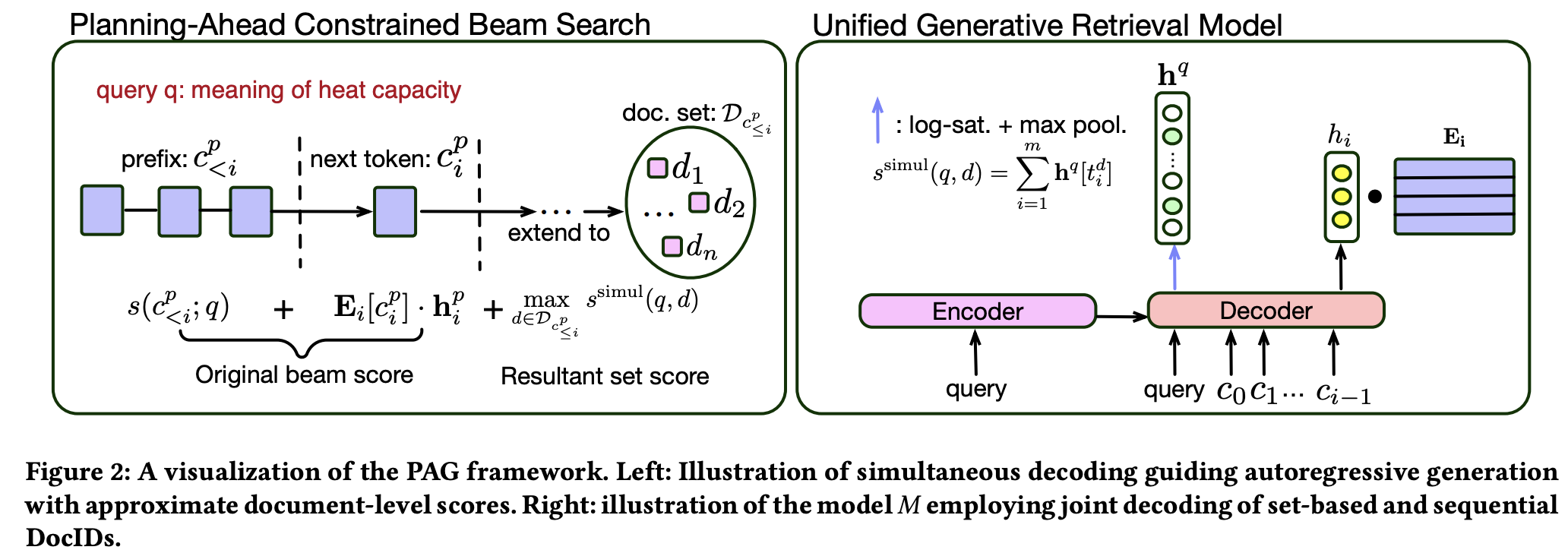This repo provides the source code and checkpoints for our paper Planning Ahead in Generative Retrieval: Guiding Autoregressive Generation through Simultaneous Decoding. We introduces PAG–a novel optimization and decoding approach that guides autoregressive generation of document identifiers in generative retrieval models through simultaneous decoding. To this aim, PAG constructs a set-based and sequential identifier for each document. Motivated by the bag-of-words assumption in information retrieval, the set-based identifier is built on lexical tokens. The sequential identifier, on the other hand, is obtained via quantizing relevance-based representations of documents. Extensive experiments on MSMARCO and TREC Deep Learning Track data reveal that PAG outperforms the state-of-the-art generative retrieval model by a large margin (e.g., 15.6% MRR improvements on MS MARCO), while achieving 22x speed up in terms of query latency.
- pip install -r requirements.txt
- pip install torch==1.10.0+cu111 -f https://download.pytorch.org/whl/torch_stable.html
- conda install -c conda-forge faiss-gpu
All necessary files and checkpoint are in PAG-data. If only want to do inference, you only need to download the following files or folders.
- Trained model:
experiments-full-lexical-ripor/lexical_ripor_direct_lng_knp_seq2seq_1
- Files for sequential and set-based DocIDs:
experiments-full-lexical-ripor/t5-full-dense-1-5e-4-12l/aq_smtid/docid_to_tokenids.jsonexperiments-splade/t5-splade-0-12l/top_bow/docid_to_tokenids.json
- MS MARCO data
msmarco-full/full_collection,msmarco-full/TREC_DL_2019/,msmarco-full/TREC_DL_2020/queries_2020/,msmarco-full/dev_qrel.json
We use a single 80GB A100 to run the script. Feel free to use other types of GPUs, such as V100, but it would be slower.
Make sure that the task variable in line 1 of full_scripts/full_lexical_ripor_evaluate.sh is set to lexical_constrained_retrieve_and_rerank, then run:
bash full_scripts/full_lexical_ripor_evaluate.sh
All experiments are conducted 8x 40GB A100 GPUs. The whole training pipeline contains three stages: (1) Generative retrieval (GR) model for set-based DocIDs. (2) GR model for sequence-based DocIDs. (3) Unified GR model for set-based & sequence-based DocIDs. Stages (1) and (2) can be train in parallel.
The stage contains 2 phases: pre-training and fine-tunining. For pre-training, we train the GR model as a sparse encoder, then we select the top m words from the sparse vector for each document
Run script for training the sparse encoder:
bash full_scripts/t5_splade_train.sh
Once model trained, run the following script to get the set-based DocIDs:
bash full_scripts/t5_splade_get_bow_rep.sh
We apply the two-step fine-tuning stragegy. The negatives for the step 1 is from BM25, and the negatives for the step 2 is from the step 1 model itself. For step 1 training:
- please first set
finetune_step=bm25_negin filefull_scripts/t5_full_term_encoder_train.sh, then run:
full_scripts/t5_full_term_encoder_train.sh
For step 2 training:
- We need to mine the negative documents using step 1 model (named as
t5-term-encoder-0-bow-12l) and assign the teacher score using a cross-encoder for each query-document pair. The procedures are integreted in the scriptfull_scripts/t5_full_term_encoder_evaluate.sh, when we settask="retrieve_train_queries"in line 3 of the script:
bash full_scripts/t5_full_term_encoder_evaluate.sh
- After running the script, you should obtain a train file in the path
/YOU_PREFIX/t5-term-encoder-0-bow-12l/out/MSMARCO_TRAIN/qid_pids_rerank_scores.train.json. Then run the following .py script to add the qrel document (if missed) to theqid_pids_rerank_scores.train.json(Remember to setexperiment_names = ["t5-term-encoder-0-bow-12l"]in line 13 of the .py file.):
python t5_pretrainer/full_preprocess/add_qrel_to_rerank_run.py
- You will obtain the final train file:
/YOU_PREFIX/t5-term-encoder-0-bow-12l/out/MSMARCO_TRAIN/qrel_added_qid_docids_teacher_scores.train.json. Please first setfinetune_step=self_negin filefull_scripts/t5_full_term_encoder_train.sh, then train the step 2 model:
bash full_scripts/t5_full_term_encoder_train.sh
The stage also contains pre-training and fine-tuning phases. And the training pipline is the same as RIPOR [https://arxiv.org/pdf/2311.09134.pdf] except we don't use progressive training (We found the progressive training requires too much training time, and do not significantly influence the model effectiveness).
We treat the GR mdoel as a dense encoder and apply the two-step training strategy:
For step 1:
- please first set
finetune_step=bm25_negin filefull_scripts/t5_full_dense_train.sh, then run:
bash full_scripts/t5_full_dense_train.sh
For step 2:
- First, we need to mine the negative documents using the step 1 model (named
t5-full-dense-0-5e-4-12lt5-full-dense-0-5e-4-12l). Settask=retrieve_train_queriesin the line 2 of scriptfull_scripts/t5_full_dense_evaluate.sh, then run:
bash full_scripts/t5_full_dense_evaluate.sh
- The mined negative document file should be in the path
/YOU_PREFIX/experiments-full-lexical-ripor/out/MSMARCO_TRAIN/run.json. Next, we apply the cross-encoder to assign the teacher scores for the file:
bash full_scripts/rerank_for_create_trainset.sh
- You should obtain a file in the path
/YOU_PREFIX/experiments-full-lexical-ripor/out/MSMARCO_TRAIN/qid_docids_teacher_scores.train.json. Setexperiment_names = ["t5-full-dense-0-5e-4-12l"]in the line 13 of .py filet5_pretrainer/full_preprocess/add_qrel_to_rerank_run.py, then run:
python t5_pretrainer/full_preprocess/add_qrel_to_rerank_run.py
- You will obtain the trained file
/YOU_PREFIX/experiments-full-lexical-ripor/out/MSMARCO_TRAIN/qrel_added_qid_docids_teacher_scores.train.json. To train the step 2 model, please first setfinetune_step=self_negin the line 8 of filefull_scripts/t5_full_dense_train.sh, then run:
bash full_scripts/t5_full_dense_train.sh
- After training we can run the following script to obtain sequence-based DocIDs. please first set
task=all_aq_piplinein filefull_scripts/t5_full_dense_evaluate.sh, then run:
bash full_scripts/t5_full_dense_evaluate.sh
- As shown in the paper, seq2seq pre-training can improve the GR model performance. Run the following script for training:
bash full_scripts/full_ripor_initial_train.sh
Let us apply the rank-oriented fine-tuning in this stage. Please run the script:
bash full_scripts/full_ripor_direct_lng_knp_train.sh
We need to the merge weights of the above two trained GR models.
First, move your terminal current directory to t5_pretrainer:
cd t5_pretrainer
Second, run the following code to merge weiths:
python -m full_preprocess.merge_model_weights
Third, move your terminal current directory back:
cd ..
Now, we can finally fine-tune the model. Run the following script:
bash full_scripts/full_lexical_ripor_train.sh
